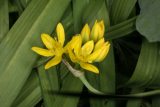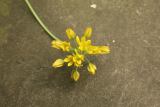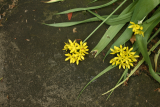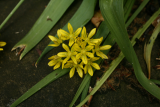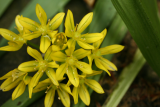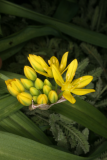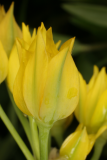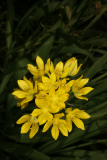Additional notes (click to expand)
Nomenclature
Family changed from Alliaceae to Amaryllidaceae 13/11/2023
http://powo.science.kew.org/
Other use
Allium moly L., Alliaceae. Golden garlic. Bulbous herb. Distribution: Southwest Europe and Northwest Africa. This is not the 'moly' of Homer's Odyssey Book 10 lines 302-6 which describes Mercury giving Ulysses 'Moly', the antidote to protect himself against Circe's poison '"... The root was black, while the flower was as white as milk; the gods call it Moly, and mortal men cannot uproot it, but the gods can do whatever they like. ' ie wrong colour, Allium moly has yellow flowers, and - acording to Parkinson (1629) has white roots. The 'Moly' of Dioscorides is 'four cubits' (two metres) high, with white flowers (Beck, 2005). Allium moly might grow to 50cm. It is poisonous.
Oakeley, Dr. Henry F. (2013). Wellcome Library notes.
link
Bulb - raw or cooked. A pleasant mild garlic flavour, when sliced it makes a very nice addition to salads and can also be used as a flavouring in cooked foods. The bulbs are about 25mm in diameter. Leaves - raw or cooked. Flowers - raw. The yellow flowers make an attractive garnish on salads and have a pleasant onion flavour.
http://www.pfaf.org,
Toxicity
Although no individual reports regarding this species have been seen, there have been cases of poisoning caused by the consumption, in large quantities and by some mammals, of certain members of this genus. Dogs seem to be particularly susceptible.
Plants for a Future (2016) at www.plantsforafuture.org.uk http://www.pfaf.org/user/Plant.aspx?LatinName=Allium+moly
link
Geographical distribution
- Europe, Southwestern Europe, France
- Europe, Southwestern Europe, Spain
Allium moly L.
Family: AMARYLLIDACEAEGenus: Allium
Species: moly L.
Common names: Moly
Distribution summary: France, Spain
Habit: Bulbous
Hardiness: H5 - Hardy; cold winter
Habitat: Rocky slopes
Garden status: Currently grown
Garden location: Classical Europe & Middle East (I)
Flowering months: June, July
Reason for growing: Other use, toxic
